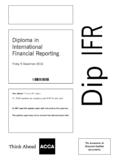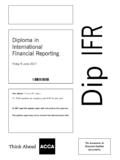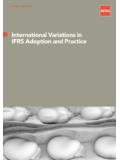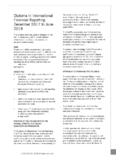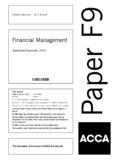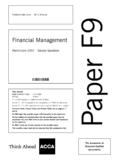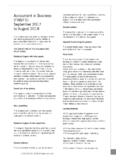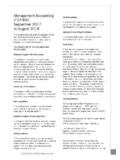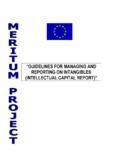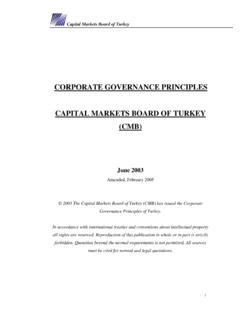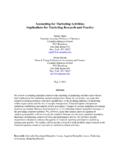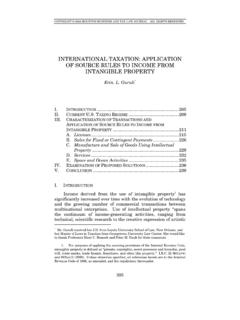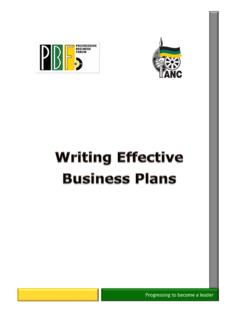Transcription of Financial Accounting (F3/FFA) September 2017 to …
1 Financial Accounting explains in further detail what the examination intends to assess and how. (F3/FFA) Detailed syllabus September 2017 to This shows the breakdown of the main capabilities August 2018 (sections) of the syllabus into subject areas. This is the blueprint for the detailed study guide. This syllabus and study guide are designed to help with teaching and learning and is intended to Approach to examining the syllabus provide detailed information on what could be assessed in any examination session. This section briefly explains the structure of the examination and how it is assessed. THE STRUCTURE OF THE SYLLABUS AND. STUDY GUIDE Study Guide Relational diagram with other papers This is the main document that students and learning and content providers should use as the This diagram shows direct and indirect links basis of their studies, instruction and materials between this examination and other examinations respectively.
2 Which precede or follow it. Some examinations are Examinations will be based on the detail of the directly underpinned by others. These links are study guide which comprehensively identifies what shown as solid line arrows. The indirect links are could be assessed within any examination session. shown as dotted line arrows. The relational diagram The study guide is a precise reflection and therefore indicates where learners are expected to breakdown of the syllabus. It is divided into sections have underpinning knowledge and where it would based on the main capabilities identified in the be useful to review previous learning before syllabus. These sections are divided into subject undertaking study. areas which relate to the sub-capabilities included in the detailed syllabus.
3 Subject areas are broken Overall aim of the syllabus down into sub-headings which describe the detailed outcomes that could be assessed in examinations. This explains briefly the overall objective of the These outcomes indicate what exams may require examination and indicates in the broadest sense the students to demonstrate, and the broad intellectual capabilities to be developed within the examination. level at which these may need to be demonstrated (*see intellectual levels below). Main capabilities LEVEL OF ASSESSMENTS INTELLECTUAL. DEMAND. This syllabus's aim is broken down into several main capabilities which divide the syllabus and ACCA qualifications are designed to progressively study guide into discrete sections. broaden and deepen the knowledge and skills demonstrated by the student at a range of levels through each qualification.
4 Relational diagram of main capabilities Throughout, the study guides assess both This diagram illustrates the flows and links between knowledge and skills. Therefore a clear distinction is the main capabilities (sections) of the syllabus and drawn, within each subject area, between assessing should be used as an aid to planning teaching and knowledge and skills and in assessing their learning in a structured way. application within an Accounting or business context. The assessment of knowledge is denoted by Syllabus rationale a superscriptK and the assessment of skills is denoted by the superscriptS. This is a narrative explaining how the syllabus is structured and how the main capabilities or sections of the syllabus are linked. The rationale also 1.
5 ACCA 2017 -18 All rights reserved. VALUE OF ASSESSMENTS GUIDED LEARNING The term issued or passed relates to when HOURS AND EDUCATION RECOGNITION regulation or legislation has been formally approved. The term effective relates to when regulation or As a member of the International Federation of legislation must be applied to entity transactions Accountants, ACCA seeks to enhance the education and business practices. recognition of its qualification on both national and international education frameworks, and with The study guide offers more detailed guidance on educational authorities and partners globally. In the depth and level at which the examinable doing so, ACCA aims to ensure that its qualifications documents will be examined.
6 The study guide are recognized and valued by governments, should therefore be read in conjunction with the regulatory authorities and employers across all examinable documents list. sectors. To this end, ACCA qualifications are currently recognized on the education frameworks in several countries. Please refer to your national education framework regulator for further information about recognition. GUIDE TO EXAM STRUCTURE. The structure of examinations varies within and between modules and levels. The Foundations examinations contain 100%. compulsory questions to encourage candidates to study across the breadth of each syllabus. All Foundations examinations are assessed by two- hour paper based and computer based examinations. The pass mark for all FIA examination papers is 50%.
7 GUIDE TO EXAMINATION ASSESSMENT. ACCA reserves the right to examine anything contained within any study guide within any examination session. This includes knowledge, techniques, principles, theories, and concepts as specified. For specified Financial Accounting , audit and tax papers, except where indicated otherwise, ACCA. will publish examinable documents once a year to indicate exactly what regulations and legislation could potentially be assessed within identified examination sessions. For this examination regulation issued or legislation passed on or before 31st August annually, will be assessed from September 1st of the following year to August 31st of the year after. Please refer to the examinable documents for the paper (where relevant) for further information.
8 Regulation issued or legislation passed in accordance with the above dates may be examinable even if the effective date is in the future. 2. ACCA 2017 -18 All rights reserved. Qualification Structure The qualification structure requires candidates who wish to be awarded the Diploma in Accounting and Business to pass the F1/FAB, F2/FMA and the F3/FFA examinations and successfully complete the Foundations in Professionalism module Diploma in F1/FAB F2/FMA F3/FFA. + + + FiP* = Accounting and Business * Foundations in Professionalism Syllabus Structure The Foundations in Accountancy suite of Students are recommended to enter Foundations in qualifications is designed so that a student can Accountancy at the level which is most appropriate progress through three discrete levels; Introductory to their needs and to take Certificate level, Intermediate Certificate level and examinations in order, but this is not a mandatory the Diploma level.
9 Requirement P2 ACCA. F7. FIA FFA F3. FA2. FA1. 3. ACCA 2017 -18 All rights reserved. Syllabus Financial statements from the individual Financial statements of group incorporated entities. AIM MAIN CAPABILITIES. To develop knowledge and understanding of the underlying principles and concepts relating to On successful completion of this paper, candidates Financial Accounting and technical proficiency in the should be able to: use of double-entry Accounting techniques including the preparation of basic Financial statements. A. Explain the context and purpose of Financial reporting RATIONALE. B. Define the qualitative characteristics of The syllabus for Paper FFA/F3, Financial Financial information Accounting , introduces the candidate to the fundamentals of the regulatory framework relating to C.
10 Demonstrate the use of double-entry and accounts preparation and to the qualitative Accounting systems characteristics of useful information. The syllabus then covers drafting Financial statements and the D. Record transactions and events principles of accounts preparation. The syllabus then concentrates in depth on recording, processing, E. Prepare a trial balance (including identifying and reporting business transactions and events. The and correcting errors). syllabus then covers the use of the trial balance and F. Prepare basic Financial statements for how to identify and correct errors, and then the incorporated and unincorporated entities. preparation of Financial statements for incorporated and unincorporated entities. The syllabus then G.


